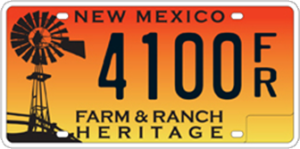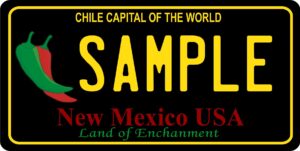New Mexico Farm and Ranch Heritage license plates, adorned with vibrant colors and imagery, symbolize the region’s agricultural legacy, farming, and ranching heritage.
Beyond their aesthetic appeal, the agriculturally themed specialty plates also play a practical role in supporting ag education and preservation efforts in New Mexico. Revenue generated from the sale of these plates helps fund programs and initiatives through the New Mexico Farm and Ranch Heritage Museum aimed at preserving the state’s agricultural heritage, supporting agricultural education, and promoting sustainable farming practices.

Located in Las Cruces, New Mexico, the 47-acre museum offers visitors a glimpse into the diverse heritage and practices that have shaped the landscape and economy of the Southwest.
“The New Mexico Farm & Ranch Heritage license plate is a great way to honor our state’s agricultural history and also support education at the Museum,” museum staff said.
Agriculture is deeply rooted in New Mexico, with over 43.2 million acres of farmland in production and 24,000 family-owned farms and ranches accounting for 95 percent of the state’s total agricultural operations. The top agricultural products for New Mexico include milk, beef cattle and calves, pecans, hay, sheep, onions, chile, greenhouse, cotton, corn, wheat, poultry, and eggs.
However, with nearly $4 billion dollars in revenue generated by New Mexico farms each year, the state’s chile and pecan production are ranked in the top two spots in the nation. Among other top commodities, onion production ranks fifth in the nation, milk ranks ninth, and cattle and calves ranks 21st.
The Farm & Ranch Heritage plate was first introduced into legislation in 2009 by then-state Rep. Brian Egolf. Gov. Bill Richardson signed the bill after the state legislature passed it, and the plate became available for vehicle registration from the state’s Motor Vehicle Division in 2010.
The windmill and sunset design was selected by the Farm & Ranch Heritage Museum’s board of directors from possibilities created by graphic artists on the museum staff.
Plates can be obtained for $37. The first $12 of the $37 additional fee is retained (by statute) by the NMMVD to cover the costs of printing the plate and administering the program. The remaining $25 is turned over to the New Mexico Farm & Ranch Heritage Museum’s Education Department to support their programming.
Just like other specialty license plates in the state, renewals are completed annually, and an additional $35 fee is charged each year, with $25 always distributed to the museum’s educational programs.
One of the programs that the museum uses the money to enhance is the Big Yellow School Bus Fund, a program developed in 2006 to offer “bus scholarships” to help schools offset the costs of a field trip visit to the Museum. A school is typically charged $100-300 for each bus they need when they take a field trip, but with scholarships, students.
Along with the Farm and Ranch Heritage plates, New Mexicans can also purchase plates to support 4-H and FFA, among other organizational support plates. The FFA plate can be purchased for a fee of $35.00 in addition to regular motor vehicle registration fees, and the 4-H plate can be purchased for a $37.00 additional fee on top of the regular registration.
However, there exists one other ag-centric plate in the Land of Enchantment that requires no additional fee — the New Mexico Chile Capital of the World license plate.
With thousands of acres in production, New Mexico took part in a race to beat out its chile competitor, Colorado, for the chile license plates. The compelling dispute between Colorado and New Mexico about which state grows better green chile likely started during the 2014 Super Bowl when Denver’s Mayor Michael Hancock wagered a sampling of green chile from restaurants sourcing their peppers from Colorado and New Mexico.
New Mexico said, “not so fast,” purchasing billboards in Colorado stating the number of miles left to “real” green chile and “[Chile Capital of the World]” placed around the state, even in Denver and launching a video advertisement campaign for the Hatch chile peppers. In 2019, one of the New Mexico True billboards was defaced by rival Coloradans, removing the number of miles to New Mexico and replacing it with a “0.”
While New Mexico is known for its famous Hatch peppers, the Hatch chile pepper is not actually a variety, but a marketing term referring to New Mexico chile that has been grown in the Hatch Valley of New Mexico. Meanwhile, to the north, Pueblo, Colo. grows a variety named the Mirasol Mosco.
As part of the competition between New Mexico and Colorado, a bill was set to create a specialty chile license plate was announced in 2017. However, Gov. Susana Martinez vetoed the bill, ensuring that chile lovers could secure the plate without any additional specialty plate fees, as no groups or organizations benefit from the purchase of the plate.
That same year, New Mexico celebrated its chile production approving the unique license plate featuring red and green chile peppers with yellow license plate numbers.



